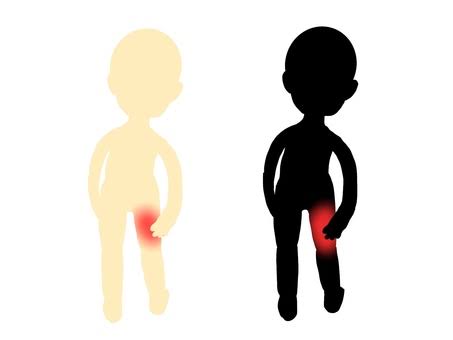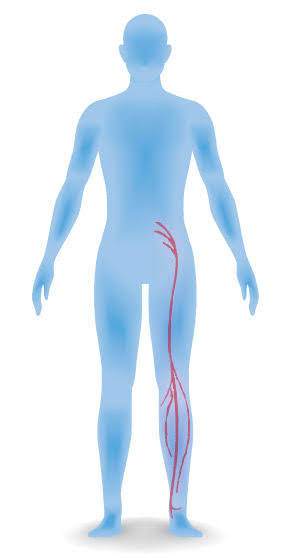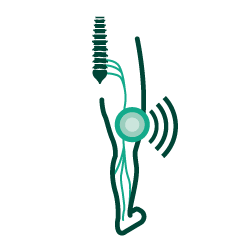Sciatica is a widespread, frequently excruciating ailment that impacts millions of individuals around. Sciatica is a condition that radiates pain along the sciatic nerve, which passes through your hips, buttocks, and legs from your lower back. It can seriously reduce your quality of life.
We will delve into the world of sciatica in this thorough beginner’s guide, examining its description, pathology, kinds, causes, risk factors, signs and symptoms, investigations, and differential diagnosis. We will also go over the general care and prevention of sciatica, emphasizing the advantages of homeopathy as a form of treatment.

The Meaning of Sciatica
Pain that spreads along the sciatic nerve’s route is referred to as sciatica, also known as lumbar radiculopathy. The longest nerve in the human body begins in the lower back and travels down each leg, passing through the buttocks. Sciatica is frequently brought on by compression or irritation of the sciatic nerve, which can result in a variety of symptoms, the most common of which is pain, which can be moderate or severe.
The Pathology of Sciatica
Compression of the sciatic nerve is a common cause of the pathophysiology of sciatica. Numerous conditions, such as herniated discs, bone spurs, spinal stenosis, or even inflammation of the muscles, can cause this compression. In the affected limb, discomfort, numbness, tingling, and muscle weakness might result from compression of the nerve.
Different Kinds of Sciatica
Sciatica can take on various forms, each with distinct features. There are two main kinds of sciatica:
1. Acute Sciatica: This kind of sciatica is frequently abrupt and severe, resulting in excruciating pain that could endure for many weeks. It usually happens as a result of a particular spinal trauma or injury.
2. Chronic Sciatica: This is a persistent sciatica that lasts longer than 12 weeks. It is frequently brought on by underlying problems such spinal degeneration or ruptured discs.
Why is Sciatica Caused?
Comprehending the fundamental reasons behind sciatica is essential for efficient handling. Sciatica is often caused by:
1. Herniated Discs: The sciatic nerve may be compressed when the pliable, gel-like core of a spinal disc pushes through the harder outer layer.
2. Spinal Stenosis: This disorder causes the spinal canal to narrow, compressing the nerve roots.
3. Bone Spurs: The sciatic nerve may become compressed as a result of bone development over time.
4. Spondylolisthesis: This is a condition in which a vertebra misaligns, compressing a nerve.
5. Piriformis Syndrome: The sciatic nerve may get irritated or compressed by the piriformis muscle, which is located in the buttocks. This can result in discomfort.
The Risky Elements
Sciatica can be brought on by a number of circumstances, such as:
1. Age: As we become older, the normal degeneration of our spinal discs increases our vulnerability to disorders like herniated discs.
2. Occupation: Prolonged sitting or heavy lifting are two jobs that increase the risk of sciatica.
3. Obesity: Carrying too much weight can strain the spine and raise the risk of nerve compression.
4. Diabetes: Because the condition affects nerve health, those with diabetes may be more vulnerable.
The Signs and Symptoms of Sciatica
Early diagnosis and treatment of sciatica depend on the ability to recognize its symptoms. Typical signs and symptoms include of:
1. Radiating Pain: A sharp, shooting pain that travels down one leg from the lower back is the primary symptom of sciatica.
2. Numbness and Tingling: Many people with sciatica report feeling numb or tingly in the leg that is afflicted.
3. Muscle Weakness: It can be difficult to walk or stand if there is weakness in the leg or foot.
4. Difficulty Sitting: Extended periods of sitting might exacerbate pain, necessitating regular position changes.
5. Lower Back Pain: Mild to severe lower back pain is a common side effect of sciatica.
Investigations of Sciatica
A combination of the patient’s medical history, physical examination, and diagnostic testing is usually used to diagnose sciatica. Among the studies done to determine the cause of sciatica are:
1. Imaging Studies: By providing detailed images of the spine, X-rays, CT scans, and MRIs can assist in determining the underlying cause of sciatica.
2. Electromyography (EMG): This test helps identify whether nerve compression is the source of muscle weakness by measuring the electrical activity in the muscles.
3. Nerve Conduction Studies: These investigations can detect nerve injury by measuring the rate at which electrical signals pass through the nerves.
Differential Diagnosis of Sciatica
Accurately diagnosing sciatica from other illnesses that share similar symptoms is essential for the right course of treatment. Differentially diagnosing the following conditions from sciatica:
1. Lumbar Disc Disease: Although it may not always affect the sciatic nerve, this condition might resemble sciatica symptoms.
2. Dysfunction of the Sacroiliac Joint: Similar to sciatica, pain in the sacroiliac joint can travel down the leg.
3. Piriformis Syndrome: Because the piriformis muscle compresses the sciatic nerve, this disorder might have symptoms that are comparable to sciatica.
4. Peripheral Neuropathy: Conditions like diabetes can produce peripheral neuropathy, which can have similar symptoms but needs to be treated differently.
General Management of Sciatica
Sciatica management frequently entails a multifaceted strategy that is adapted to the needs and circumstances of the individual. The following are some common sciatica management techniques:
1. Pain Relief: Ibuprofen and acetaminophen, two over-the-counter pain medications, can offer temporary relief. Medication on prescription can be required in more serious situations.
2. Physical Therapy: A tailored program of physical therapy can help lessen pain, increase strength and flexibility, and stop sciatica attacks in the future.
3. Exercise at Home: Following a physical therapist’s recommendations, performing particular exercises at home can help speed up the healing process.
4. Hot and Cold Therapy: Alternately applying heat and cold to the afflicted area might help ease pain and reduce inflammation.
5. Epidural Steroid Injections: To reduce inflammation and relieve pain, corticosteroid injections may be given directly into the afflicted area in severe cases.
6. Alternative Therapies: Some people may get comfort from alternatives including massage therapy, acupuncture, and chiropractic adjustments.
Sciatica General Prevention and the Role of Homeopathy
There are things you may do to lessen the intensity of symptoms and lower your risk of developing sciatica, even though it may not be possible to prevent every instance. Among the preventive actions are:
1. Keep Your Weight in Check: Reducing obesity will lessen the strain on your spine and minimize your chance of developing sciatica.
2. Appropriate Lifting Techniques: To save your spine, utilize appropriate lifting techniques when moving big goods.
3. Remain Active: You may support your spine and avoid sciatica by engaging in regular activity that include core-strengthening exercises.
4. Ergonomic Workstation: If your employment involves a desk, ensure your workstation is set up ergonomically to reduce back strain.
5. Give Up Smoking: Reducing your risk of spinal disc degeneration can be achieved by giving up smoking.
The Role of Homeopathy in Treating Sciatica
Stimulating the body’s natural healing processes is the main goal of homeopathy, a holistic therapeutic method. Based on the idea of “like heals like,” a chemical that would produce symptoms in a healthy person is used to treat the same symptoms in a sick person by diluting it greatly. Homeopathy provides a safe, all-natural method of treating sciatica symptoms.
Homeopathic Remedies for Sciatica
1. Colocynth: Uses light pressure or heat to relieve hip discomfort that radiates from the left side and resembles cramping, affecting the knee. 3–5 tablets, three times a day, are the recommended dosage (6C–30C).
2. Magnesium Phosphorica: Reduces sciatic pain on the right side, accompanied by tingling and darting sensations in the feet; friction, pressure, and warmth can all help. Three pills, three times a day, is the recommended dosage (1C – 12C).
3. Gnaphalium: Treats severe sciatic pain along the nerve, alternating between agony and numbness. Frequently, recurrent aches in the calves and feet are also experienced. Flexing the thigh on the abdomen or pulling the limbs up will provide relief. Dosage: three to five pills, three times a day (3C to 30C).
4. Rhus Toxicodendron: Reduces sciatic pain that gets worse at rest and increases the need to move constantly. Dosage recommendations: 3–5 tablets, three times a day (6C–200C).
5. Bryonia Alba: Preferably, rest is advised for sciatica pain that is produced even by light motion. 3 tablets, three times a day, 1C to 12C is the dosage.
A professional and knowledgeable homeopathic practitioner must be consulted in order to do an accurate assessment and create a customized treatment plan. For anyone seeking a different or supplemental method of treating sciatica, homeopathy is a reliable and safe choice.

Conclusion: A Pain-Free Life!
Sciatica can be a crippling illness that has an impact on many areas of your life. In order to manage and avoid this ailment, the first step is to understand its causes, symptoms, and available treatments. Homeopathy offers a natural and holistic approach that may offer great relief to patients with sciatica, even when conventional treatments are useful as well.
Seeking advice from medical professionals is essential if you or someone you know is suffering from sciatic pain in order to decide on the best course of action. The aim is the same whether one chooses to use homeopathy, conventional medicine, or a mix of the two: to assist people in regaining their mobility and improving their quality of life.
Remember that since every person’s experience with sciatica is different, the course of treatment should be customized to meet their individual requirements and preferences. You may work toward a better, pain-free future by managing and avoiding sciatica proactively.
Reach out to us for a Consultation.
This blog is for information purposes. It’s crucial to note that while homeopathy is a centuries-old practice with many adherents worldwide, always consult a qualified homeopath or medical professional before initiating any treatment.
For any queries, reach out to us at contact@homeopathic.ai





